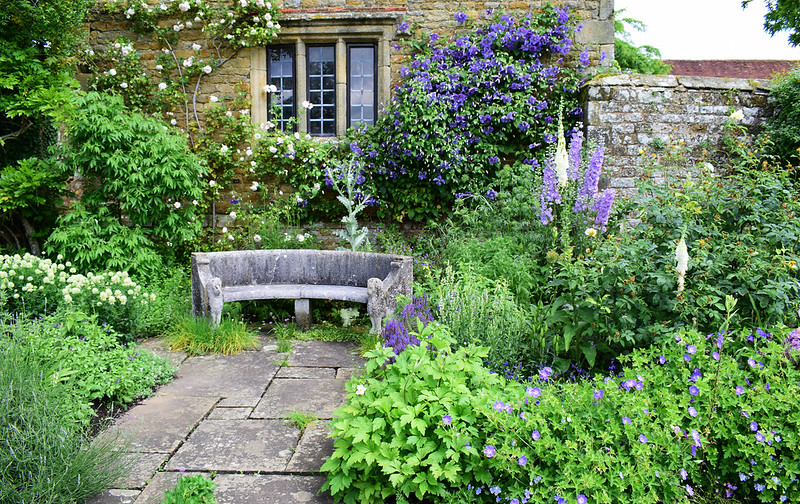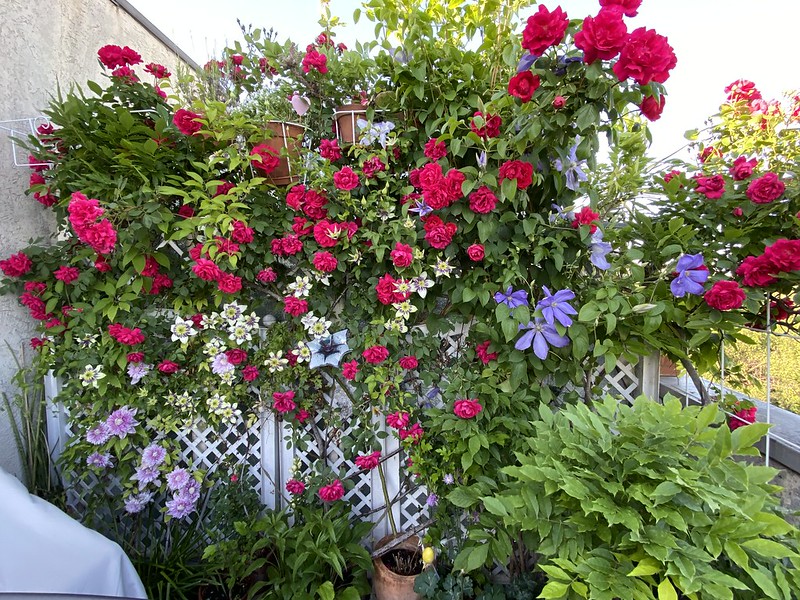Clematis is the queen of the perennial climbers. There is a variety perfect for any size of garden or container. Rambling types can be left to scramble through trees and shrubs with little fear of them taking over. Newer varieties grow upright without the need for elaborate trellising, topping out at 5-7 feet with extra sturdy stems and nonstop flowering. When designing a garden, vertical growing plants are able to give a small growing space the feeling of depth and interest. Clematis is fairly easy going to grow and is adaptable to different growing conditions, making them a great companion plant for many different plants in the garden.

Photo by Mark Wordy, unmodified, Flickr, Copyright CC By 2.0
Often Clematis are described as needing their heads in the sun and shade at their feet. With that in mind, make sure to plant Clematis where they will be guaranteed at least 6 hours of direct sun exposure for the top of the plant. This ensures good flowering and healthy vine growth. Any plants paired with Clematis should be able to thrive in consistently moist soil that drains well and has a pH near neutral (7.0). Although Clematis has been traditionally used to cover the sides of sheds or other structures, they can be used in just about any garden design, even in kitchen gardens to help attract beneficial pollinators.
Shrubs To Plant With Clematis
Clematis makes a great partner for either tall or short shrubs. The taller shrubs such as Hydrangea, Butterfly Bush, and Viburnum all are sturdy enough to allow Clematis to ramble and climb through their deciduous foliage. The most classic pairing for Clematis is Roses, either shrub types or ramblers. Lower-growing shrubs such as Azalea, Spirea, or Abelia do a great job of shading the lower portions of Clematis. These shrubs shade the soil and allow Clematis to grow in locations that may be too hot otherwise. Try pairing Clematis with evergreen shrubs such as Juniper, Boxwood, or Euonymus. The flowers of Clematis will be set off by the evergreen backdrop.
Space any shrub about 12 inches away from the root ball of your Clematis. This allows the plants to intermingle while still maintaining good air circulation.

Photo by Tauralbus, unmodified, Flickr, Copyright CC By 2.0
Perennials To Plant With Clematis
Perennials are the easiest plants to grow with Clematis. Both herbaceous and hardy perennials can be counted on to shade the base of Clematis vines, keeping their roots cool. Coneflowers, Daylilies, and Penstemon are great choices for extra hot and sunny spots. They will gently spread with no risk of overwhelming neighboring plants. Plants that prefer more shade such as Delphinium, Hosta, and Ferns can also be grown with Clematis, especially the types of Clematis that are sturdy and require little extra support.
Annuals To Plant With Clematis
Annuals work well with Clematis in a garden. A gardener can use the Clematis as a starting point to try out different color combinations or planting schemes from year to year. The shallow root systems of annuals do not compete with the deeper-growing Clematis roots for water or nutrients. Larkspur, Nicotina, and Marigolds reach a medium height that can shade the lowering stems of Clematis. Petunias, Alyssum, and Nasturtiums are effective ground covers that not only help suppress weeds but also deter or act as ‘catch plants’ for aphids and other insect pests.
An unconventional but wonderful use of Clematis is in the vegetable garden. The vines can be trained to climb almost any vertical surface and provide a good amount of shade for summer greens such as Spinach, head Lettuce, or Asian Greens that prefer cooler temperatures for growing.
Best Companion Plants For Clematis in Containers
Clematis is a natural choice for use in a mixed seasonal container. Their height makes them perfect for the thriller element. Add a small trellis or other support to climb on, and the stage is set for a dramatic display. Annual plants work best in mixed planters because their roots are shallow and do not interfere with other plants. Alyssum, Euphorbia, and potato vine are effective spiller elements while African daisies, snapdragons, or larkspur would make a lovely filler element.
Perennials can also grow well in a mixed container with Clematis. Larger planters are required when adding Heuchera, ornamental Alliums, or Salvia. Repotting and dividing the perennial plants yearly will also help keep them growing vigorously.
Be careful to not over-fertilize mixed plantings in containers. Dense, lush foliage is more likely to encourage aphids and other pest insects. Apply a diluted liquid seaweed or fish emulsion fertilizer at half the recommended dose once a month from April to August.
Plants Not to Grow With Clematis
Clematis does not make a good companion for plants that are extremely drought tolerant or require little fertilization. Most woody herb plants, such as Lavender, Rosemary, and Thyme require little to no extra fertilizing or supplemental watering during the summer. Clematis is not able to cope with those conditions for very long. The growth and blooming of Clematis would be limited under these conditions. Other Mediterranean or desert-type plants (cacti, most succulents, and Agave) also do not pair well with Clematis.
Best Plants To Grow With Clematis
The best plants for growing with Clematis prefer a neutral pH, good drainage and moderately fertile soil. Plants that prefer full sun to partial shade are perfect for growing at the base of a Clematis. When it comes to pairing plants with Clematis, most combinations will work in the right context.
 |
Author Robbin Small - Published 8-13-2023 |




